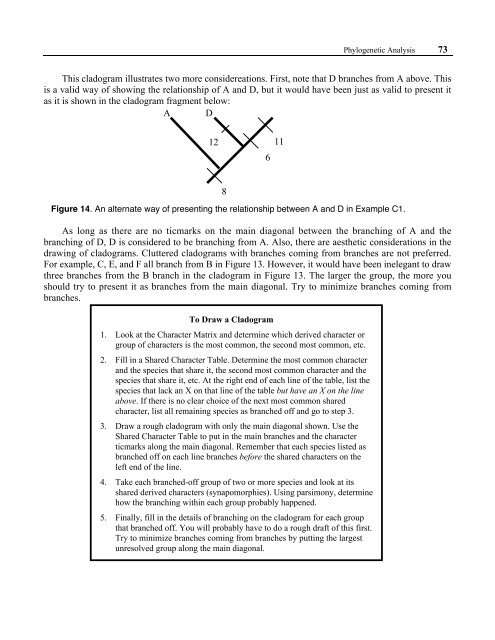An Introduction to Phylogenetic Analysis - Association for Biology ...
An Introduction to Phylogenetic Analysis - Association for Biology ...
An Introduction to Phylogenetic Analysis - Association for Biology ...
Create successful ePaper yourself
Turn your PDF publications into a flip-book with our unique Google optimized e-Paper software.
<strong>Phylogenetic</strong> <strong>An</strong>alysis 73<br />
This cladogram illustrates two more considereations. First, note that D branches from A above. This<br />
is a valid way of showing the relationship of A and D, but it would have been just as valid <strong>to</strong> present it<br />
as it is shown in the cladogram fragment below:<br />
A D<br />
12<br />
8<br />
Figure 14. <strong>An</strong> alternate way of presenting the relationship between A and D in Example C1.<br />
As long as there are no ticmarks on the main diagonal between the branching of A and the<br />
branching of D, D is considered <strong>to</strong> be branching from A. Also, there are aesthetic considerations in the<br />
drawing of cladograms. Cluttered cladograms with branches coming from branches are not preferred.<br />
For example, C, E, and F all branch from B in Figure 13. However, it would have been inelegant <strong>to</strong> draw<br />
three branches from the B branch in the cladogram in Figure 13. The larger the group, the more you<br />
should try <strong>to</strong> present it as branches from the main diagonal. Try <strong>to</strong> minimize branches coming from<br />
branches.<br />
To Draw a Cladogram<br />
1. Look at the Character Matrix and determine which derived character or<br />
group of characters is the most common, the second most common, etc.<br />
2. Fill in a Shared Character Table. Determine the most common character<br />
and the species that share it, the second most common character and the<br />
species that share it, etc. At the right end of each line of the table, list the<br />
species that lack an X on that line of the table but have an X on the line<br />
above. If there is no clear choice of the next most common shared<br />
character, list all remaining species as branched off and go <strong>to</strong> step 3.<br />
3. Draw a rough cladogram with only the main diagonal shown. Use the<br />
Shared Character Table <strong>to</strong> put in the main branches and the character<br />
ticmarks along the main diagonal. Remember that each species listed as<br />
branched off on each line branches be<strong>for</strong>e the shared characters on the<br />
left end of the line.<br />
4. Take each branched-off group of two or more species and look at its<br />
shared derived characters (synapomorphies). Using parsimony, determine<br />
how the branching within each group probably happened.<br />
5. Finally, fill in the details of branching on the cladogram <strong>for</strong> each group<br />
that branched off. You will probably have <strong>to</strong> do a rough draft of this first.<br />
Try <strong>to</strong> minimize branches coming from branches by putting the largest<br />
unresolved group along the main diagonal.<br />
6<br />
11
















